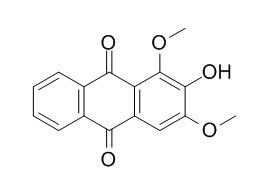9,10-Anthracenedione
9,10-Anthracenedione is a natural product from Rubia cordifolia L.
Inquire / Order:
manager@chemfaces.com
Technical Inquiries:
service@chemfaces.com
Tel:
+86-27-84237783
Fax:
+86-27-84254680
Address:
1 Building, No. 83, CheCheng Rd., Wuhan Economic and Technological Development Zone, Wuhan, Hubei 430056, PRC
Providing storage is as stated on the product vial and the vial is kept tightly sealed, the product can be stored for up to
24 months(2-8C).
Wherever possible, you should prepare and use solutions on the same day. However, if you need to make up stock solutions in advance, we recommend that you store the solution as aliquots in tightly sealed vials at -20C. Generally, these will be useable for up to two weeks. Before use, and prior to opening the vial we recommend that you allow your product to equilibrate to room temperature for at least 1 hour.
Need more advice on solubility, usage and handling? Please email to: service@chemfaces.com
The packaging of the product may have turned upside down during transportation, resulting in the natural compounds adhering to the neck or cap of the vial. take the vial out of its packaging and gently shake to let the compounds fall to the bottom of the vial. for liquid products, centrifuge at 200-500 RPM to gather the liquid at the bottom of the vial. try to avoid loss or contamination during handling.
BMC Complement Altern Med.2017, 17(1):393
Antioxidants.2022, 11(3):491.
Gene.2022, 815:146178.
Medicinal Chemistry Research 2021, 30:1117-1124.
SSRN2024, 4937625.
Analytical sci. & Tech2016, 186-193
Elife.2021, 10:e68058.
Korean J. Food Preserv.2023, 30(4):663-668.
Korean J. Crop Sci.2018, 63(2):131-139
Preprints2022, 2022030063.
Related and Featured Products
J Natl Cancer Inst. 1980 Apr;64(4):857-66.
Effects of 9,10-anthracenedione, 1,4-bis[[2-[(2-hydroxyethyl)amino]-ethyl]amino]-, diacetate on cell morphology and nucleic acids of friend leukemia cells.[Pubmed:
6928997]
METHODS AND RESULTS:
Treatment of Friend leukemia cells for 18 hours with 9,10-Anthracenedione, 1,4-bis[[(2-hydroxyethyl)amino]ethyl]amino]-, diacetate (ANT) at concentrations up to 1.0 microgram/ml induced significant changes in cell metabolism and structure. Alterations in cell nucleic acid content were detected in cells stained with acridine orange under conditions such that DNA and RNA contents could be measured simultaneously by flow cytometry. Cells treated for 18 hours with ANT at concentrations of 0.05-0.1 microgram/ml became partially blocked at the G2 phase. In addition, about 30% of the cells became polyploid and demonstrated diplochromosomes at the 8C level of mitosis. The nuclear chromatin of blocked cells had an altered structure as reflected by a change in sensitivity of DNA in situ to denaturation induced by low pH. All viable cells treated with ANT for 18 hours at concentrations of 0.4-1.0 microgram/ml were blocked in G2 phase.These cells had significantly more RNA than did untreated cells.
CONCLUSIONS:
Transmission electron microscopic observations of thin-sectioned cells suggested that this increased RNA content in ANT-treated cells was mostly due to an approximately 50% increased cell diameter and partly due to a disproportionate increase in nucleolar size. In addition, electron microscopy revealed that ANT caused increased chromatin condensation and granulation. The drug had no apparent effect on production of the endogenous Friend murine leukemia virus.



